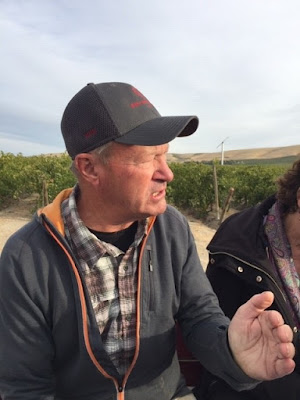Now that I've savored the Eastern Washington wine country, I can safely say that it's an area that should be experienced if you love wine touring. While the desert-like landscape is not the most impressive or picturesque that I've seen, the pockets of green vineyards are breathtakingly beautiful, and their history, geography, and geology provide a great story for the inquisitive wino (see my two previous posts for more details). Additionally, the lovely "old West" town of Walla Walla with its plethora of restaurants and tasting rooms is just plain fun. And definitely check out the Marcus Whitman Hotel for it's regal yet relaxed elegance.
Following are some notes from my recent culinary and wine adventures in Eastern Washington while attending WBC 2018.
Cadaretta's Glass House
 |
The location for the dinner that Cadaretta hosted was their gorgeous hilltop glass house. Situated atop the family's Southwind estate vineyards, which straddle Washington and Oregon, the structure is simple, functional, and totally unique. Our group was greeted with a glass of Cadaretta's Sauvignon Blanc-Semillion blend (from Columbia Valley grapes), which we sipped while watching the sun set over the vineyards below us.
Originally and still in the lumber business, the family is now committed to producing hand-crafted wines as well, with wineries in Walla Walla and California's Central Coast (Inconceivable Wines). Kris Middleton, who represents the family's fifth generation to work the business, hosted us wine bloggers and provided a lovely sit-down dinner paired with the family's luscious, rich red wines, planted on various blocks of the estate vineyards. Paired with rich, hearty fare from a local caterer, the dinner was exceptional.
Check out Cadaretta's current releases.
Dunham Cellars
This WBC Mystery Dinner is a great treat. You don't know where you are being whisked off to until you arrive there. For me it was to Dunham Cellars, which is another Walla Walla family winery. Located in the "urban" area of Walla Walla, this quaint, lovely winery is housed in a wooden barn structure that was part of a WWII era airplane hangar. Stepping inside was like entering a fairy tale, with art, twinkle lights, and a Christmas-tree-like structure composed of 500+ empty bottles of wine, also lit up and festive as can be. And our fairy god-mother was host Joan Dunham, whose late husband and step-son were her original partners in the winery.
 Joan and General Manager John Blair (his family is now partners in the winery) presided over a lovely dinner catered by local chef Candice Smith, owner of Forage Walla Walla. This five-course feast was accompanied by Dunham's Riesling, Tempranillo (my favorite), Syrah, Cabernet Sauvignon, and Late-Harvest Riesling. Beyond the closed garage doors of the dining area, a few tons of syrah grapes were being sorted ... this was definitely a working winery, and the clearly over-worked cellar manager still managed to come in and talk to us for a few minutes.
Joan and General Manager John Blair (his family is now partners in the winery) presided over a lovely dinner catered by local chef Candice Smith, owner of Forage Walla Walla. This five-course feast was accompanied by Dunham's Riesling, Tempranillo (my favorite), Syrah, Cabernet Sauvignon, and Late-Harvest Riesling. Beyond the closed garage doors of the dining area, a few tons of syrah grapes were being sorted ... this was definitely a working winery, and the clearly over-worked cellar manager still managed to come in and talk to us for a few minutes.All I can say is Thank You Dunham Cellars for making us feel so welcome!
Please check out Dunham's offering here.
Cheeses of Europe
To help them in their task at WBC they brought along the personable Cheese Twins, Michael and Charlie Kalish. These twin brothers were winners of the Great Food Truck Race on the Food Network and also finalists on the show Chopped (their episode was called "Twins for the Win"). TV notoriety aside, these bros sure know about cheese, having traveled around Europe interning with traditional cheese mongers along the way. The brothers schooled us about the cheese-making process, the biology of cheese, and the way to pair cheese with wine.
The most interesting cheese? For me, it was Mimolette, the orange cheese in the photo above, which is colored with achiote (a spice) to differentiate it from its Netherlands counterpart. This cheese is produced in cannonball shapes, and is covered with a craggy skin. To get this skin, cheese mites (yes, little critters) feast on the outside of the cheese, and form craters, which apparently add to the flavor. Sounds unappetizing, but in reality it's delicious! A hearty red is recommended to pair with this cheese.
You can get the Cheeses of Europe app on your phone. If you're looking for a hard-to-find cheese, or just want to view some "cheese porn" you will love perusing this site.
Gloria Ferrer
Sarah opined that so much of sparkling is about texture and I agree -- the bubbles add a whole new dimension above still wine. She also talked about the "third taste," which refers to when food (first taste) and wine (second taste) come together (third taste). Sparkling pairs so well with many different foods.
Sarah described Gloria Ferrer's wines as approachable, everyday sparklings. I would add that the pricing of Gloria Ferrer's sparklings are approachable too, ranging from $15 to $50.
Following are some good links if you want to plan a trip to Eastern Washington:
Visit Walla Walla: http://www.wallawalla.org/
Red Mountain AVA: http://redmountainava.com/
Marcus Whitman Hotel & Conference Center: https://marcuswhitmanhotel.com/
And to learn more about the Wine Blogger's Conference: https://winebloggersconference.org/
Until next time,
Cheers!















































